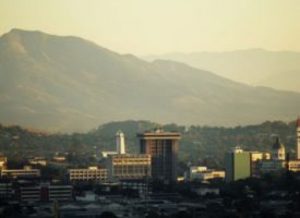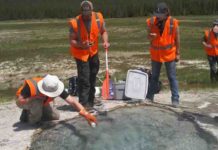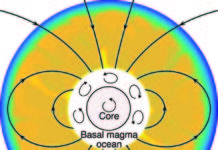
The build-up of magma six kilometres below El Salvador’s Ilopango caldera means the capital city of San Salvador may be at risk from future eruptions, University of Bristol researchers have found.
A caldera is a large cauldron-like volcanic depression or crater, formed by the collapse of an emptied magma chamber. The depression often originates from very big explosive eruptions. In Guatemala and El Salvador, caldera volcanoes straddle tectonic fault zones along the Central American Volcanic Arc (CAVA). The CAVA is 1,500 kilometres long, stretching from Guatemala to Panama.
The team, from the Volcanology research group at Bristol’s School of Earth Sciences and the Ministry of the Environment and Natural Resources in El Salvador, studied the density distribution beneath the Ilopango caldera and the role tectonic stresses – caused by the movement of tectonic plates along fault lines – have on the build-up of magma at depth. Their study is published today in the journal Nature Communications.
The Ilopango caldera is an eight km by 11 kilometre volcanic collapse structure of the El Salvador Fault Zone. The collapsed caldera was the result of at least five large eruptions over the past 80,000 years.
The last of these occurred about 1,500 years ago and produced enough volcanic ash to form a 15 centimetre thick layer across the entire UK. This catastrophic eruption destroyed practically everything within a 100 kilometre radius, including a well-developed native Mayan population, and significantly disturbed the Mayan populations as far as 200 kilometres away.
The most recent eruptions occurred in 1879–1880 and were on a much smaller scale than the previous one.
Project leader and co-author Dr Joachim Gottsmann said: “Most earthquakes take place along the edges of tectonic plates, where many volcanoes are also located. There is therefore a link between the breaking of rocks, which causes faults and earthquakes and the movement of magma from depth to the surface, to feed a volcanic eruption. The link between large tectonic fault zones and volcanism is, however, not very well understood.”
Existing studies show that magma accumulation before a large caldera-forming eruption, as well as the caldera collapse itself, may be controlled by fault structures.
“However, it is unclear to what extent regional tectonic stresses influence magma accumulation between large caldera-forming eruptions.”, co-author Professor Katharine Cashman said.
Lead author Jennifer Saxby, whose research towards a MSc in Volcanology contributed to the study, said: “Addressing this question is important not only for understanding controls on the development of magmatic systems, but also for forecasting probable locations of future eruptive activity from caldera-forming volcanoes.”
The team discovered that the current tectonic stress field promotes the accumulation of magma and hydrothermal fluids at shallow (< 6km) depth beneath Ilopango. The magma contains a considerable amount of gas, which indicates the system is charged to possibly feed the next eruption.
Dr Gottsmann said: “Our results indicate that localised extension along the fault zone controls the accumulation, ascent and eruption of magma at Ilopango. This fault-controlled magma accumulation and movement limits potential vent locations for future eruptions at the caldera in its central, western and northern part – an area that now forms part of the metropolitan area of San Salvador, which is home to 2 million people. As a consequence, there is a significant level of risk to San Salvador from future eruptions of Ilopango.”
Reference:
J. Saxby et al. Magma storage in a strike-slip caldera, Nature Communications (2016). DOI: 10.1038/ncomms12295
Note: The above post is reprinted from materials provided by University of Bristol.










